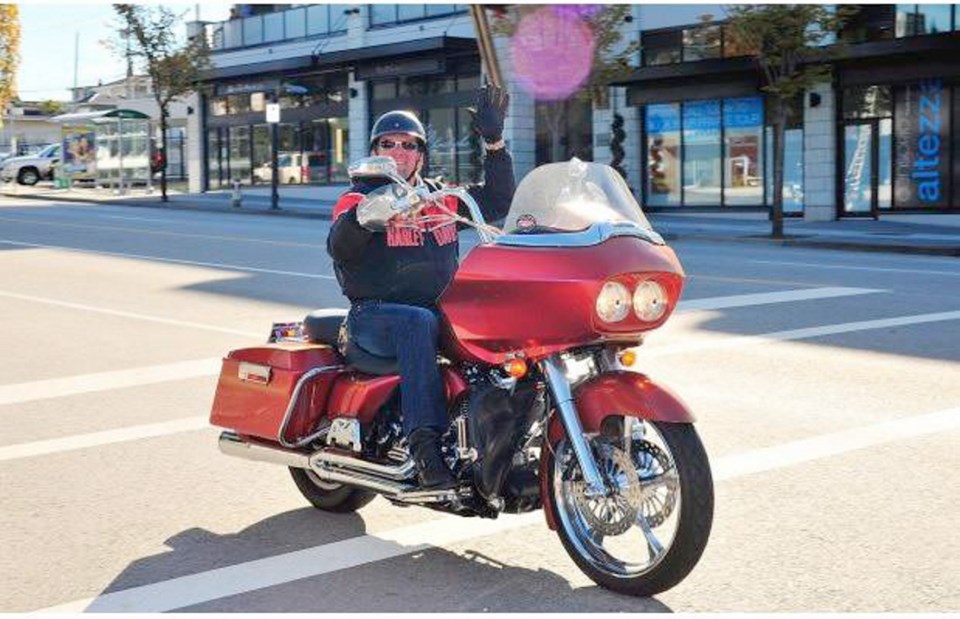As California gets set to legalize the widely accepted practice of “lane-splitting,” B.C. says there’s not a chance motorcyclists will be allowed to weave through and around traffic here.
Motorcyclists say they’re lobbying the B.C. government for a change that would allow them to drive up the middle between lanes of vehicle traffic in slow-moving traffic jams.
But the transportation ministry says it’s a no-go and it has no plans to change the law because “lane splitting can be dangerous.”
But Harley Davidson enthusiast Ron Szoczei of Delta said the practice, which he calls “lane filtering,” makes driving in traffic jams safer for motorcyclists.
“The best reason for lane filtering is for the safety of the motorcyclist, instead of having them stuck in traffic and getting rear-ended, which has happened to myself and my wife,” Szoczei said.
And he and other proponents say allowing motorcyclists the opportunity to bypass lineups would speed traffic flow for vehicle drivers.
Lane filtering would allow motorcyclists to drive between two lanes of cars as long as the bikes don’t travel more than 10 km/h faster than the traffic flow and the traffic isn’t going more than 35 km/h, according to the B.C. Coalition of Motorcyclists.
The practice is legal in 26 countries, including Ireland, Sweden and Singapore, and California is set to become the first state to legally formalize “lane splitting,” which allows the manoeuvre at even higher speeds.
A vast majority (86 per cent) of the 200 people responding to the B.C. coalition’s online poll were in favour of the change.
The coalition resubmitted in the fall a revised 2011 proposal for the change to B.C.’s transportation ministry and has been told it’s under review, according to coalition spokeswoman Tara Borgstrom.
The law now in B.C. prevents vehicles from passing other vehicles on the shoulder of the road or squeezing between two lanes of traffic.
And the law was confirmed in the courts more than a decade ago: Kenneth Dickson drove his motorcycle between two lines of cars in Vancouver on July 12, 2001, and one of those cars happened to be an unmarked police vehicle. He was ticketed and fined $86 and given a 60-day driving ban by a judicial justice of the peace. In 2003, he appealed to the Supreme Court of B.C. and lost.
Borgstrom and Szoczei argue the law as it stands puts motorcyclists in greater danger because in stop-and-go traffic, they’re more likely to be hit by cars.
And they say excessive idling can damage motorbikes, which are subject to overheating because they’re air-cooled.
“Motorcyclists say they would rather get a $140 fine for passing on the shoulder than pay $3,000 for a new engine,” Borgstrom said.
She said before the law is changed, ICBC would have to run an ad campaign to educate drivers.
And the coalition’s proposal also asks that the liability for any accidents rest with the driver of the vehicle, to ensure that road ragers don’t try to hit passing motorcyclists, she said.
Szoczei said he would understand other drivers’ resentment toward bikers who lane filter because “they’re pissed off because they’re jealous. If you could, you would.”
And he said the attitudes would take some time to adjust because “you can’t change a law like that overnight.”
The government stressed that the practice “is not legal in B.C.”
A ministry spokeswoman said the coalition submitted a proposal in 2011 and “the ministry did not support the request at the time.”
She said it hasn’t received any other requests.
“The ministry has no plans to introduce legislation to allow it,” the spokeswoman said in an email.
“While this practice is used in parts of Europe and Asia, it’s not commonly used in North America,” she said.
“Based on the findings from our research, we have found lane splitting can be dangerous, and with safety as our highest consideration, we have decided not to permit this practice in B.C.”
Tim Schewe, a retired RCMP officer who worked as a collision analyst for the force for 10 years and now runs a website called DriveSmartBC, has posted discussions on the site on the topic, including comments from motorcyclists who like the idea.
“I’d be scared to do it,” said Schewe, who lives on Vancouver Island and doesn’t ride a motorcycle. “You just have to see how people drive here. Do they mirror-signal-shoulder-check-change? No. You always have to leave yourself an out. Driving up the middle seems like a bad idea because you could be pinched up the middle.”



